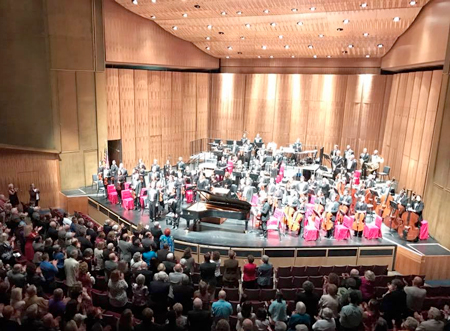by Daniel Hathaway

Apparently we have the automobile to thank for the genesis of “Rach 3.” The composer had his heart set on buying one of those newly-available machines when he agreed to an exhausting but financially rewarding North American tour of 26 concerts between October 1909 and February 1910. He wrote the third concerto expressly for the tour, and practiced it on a silent keyboard during the ocean voyage. Oddly enough, he only performed it twice — in New York on November 28 and 30 — while the more popular second concerto appeared on fourteen programs.
Although the third concerto can’t boast the big, show-stopping tunes of the second, its thematic material keeps reappearing throughout the three movements as a unifying factor. Antonio Pompa-Baldi rose heroically to the challenge of making the piano heard over a large orchestra, a task further complicated by the Thomas Hall’s cottony acoustic. He appeared to be working hard, using his down time at the beginning of the second movement to stretch out his hands behind him on the bench. Even in the thickest textures, his tone remained dark, lyrical, and unforced. His cadenzas sounded newly-minted and spontaneous.
Wilkins and the orchestra partnered expertly. Only for a moment in the heat of the finale did the ensemble become ragged. Coming at the end of the evening, Pompa-Baldi’s performance won him a huge and protracted ovation.
Earlier in the program, the combination of the American National Anthem (customarily played on opening night) and Edward Elgar’s Pomp and Circumstance March No. 2 (traditionally played on the last night of the BBC Proms in London) gave the beginning of the evening a patriotic air with influences from both sides of the Pond. The ASO’s playing of the Elgar was brilliant and festive. It was hard not to sing along when the famous tune came around.
The first half of the program was devoted to Jean Sibelius’s fifth symphony, a shining evocation of the natural world that showed off the ASO’s fine wind and brass sections, who introduced movements in chains of parallel thirds, and later crowned climaxes with golden tone. Distinguished solo work here and elsewhere during the evening came from oboist Terry Orcutt (back from a year’s leave of absence), bassoonist Todd Jelen, and hornist Meghan Guegold.
Wilkins led a well-paced performance of the symphony full of exacting detail — especially among the string sections, who delivered fine accounts of some rhythmically complex material. That insistent ostinato figure introduced by the horns that permeates the end of the work became a true earworm — as it should — though the conclusion of the piece sounded a bit too calculated. Its widely-spaced final chords needed more of a sense of surprise.
Published on ClevelandClassical.com October 6, 2016.
Click here for a printable copy of this article



